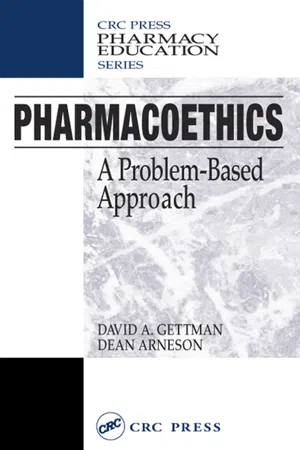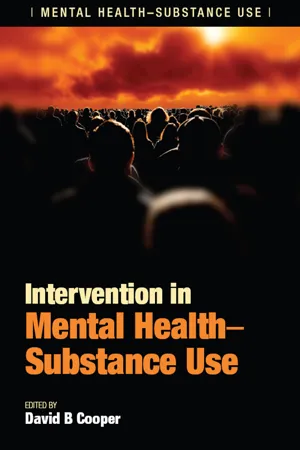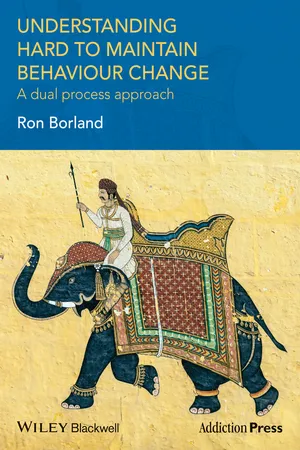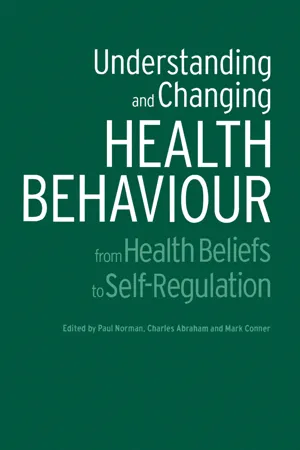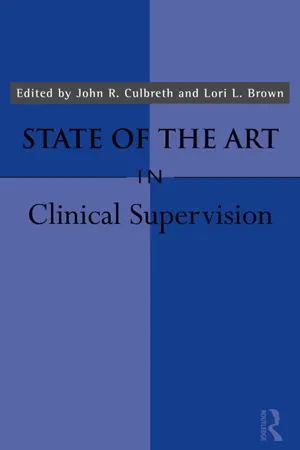Psychology
Six Stage Model of Behaviour Change
The Six Stage Model of Behavior Change, also known as the Transtheoretical Model, outlines the process individuals go through when making changes in their behavior. The stages include precontemplation, contemplation, preparation, action, maintenance, and termination. This model emphasizes that behavior change is a process that occurs over time and involves various stages of readiness and commitment.
Written by Perlego with AI-assistance
Related key terms
11 Key excerpts on "Six Stage Model of Behaviour Change"
- eBook - ePub
Public Health
Building Innovative Practice
- Linda J Jones, Jenny Douglas, Linda J Jones, Jenny Douglas(Authors)
- 2011(Publication Date)
- SAGE Publications Ltd(Publisher)
One of the most widely adopted theories of change is Prochaska and DiClemente’s (1984) Transtheoretical Theory of Change (see Figure 6.2), which was developed to explain and predict how individuals move towards adopting and maintaining health behaviour. It uses stages of change as its core construct and integrates processes and principles of change from different theories, hence the name ‘transtheoretical’. It is based on the assumption that behaviour change is an ongoing process, rather than a single event, and that individuals have varying levels of motivation or readiness to change.The theory identifies five stages of change that people will engage in:- pre-contemplation – not considering changing their behaviours or are consciously intending not to change
- contemplation – considering making a change to a specific behaviour
- preparation – making a serious commitment to change in the next couple of months and beginning to make the necessary preparations to do so
- action – explicitly making changes in their behaviour or environment
- maintenance – sustaining the change over time
- relapse – being unable to sustain the change and exiting from the cycle.
What advantages and drawbacks do you see in adopting the idea of a cycle of ‘stages’ to explain behaviour change?The model is based on observations that people appear to move through these stages in a predictable way, although some move more quickly than others and people may go backwards and forwards around the cycle. In later versions of the model, Prochaska described a final stage of ‘termination’, where individuals who have changed have no temptation to return to their old behaviour. It applies equally to individuals who ‘self-initiate’ a change and those responding to advice and encouragement to change. Stages of change theory provides a useful way of tailoring interventions to where people are in the change process. However, there is a decided lack of evidence supporting its practice or the validity of these types of staging algorithms (Riemesma et al., 2003; Brug et al., 2005). - eBook - ePub
Theories of School Psychology
Critical Perspectives
- Kristy K. Kelly, S. Andrew Garbacz, Craig A. Albers(Authors)
- 2020(Publication Date)
- Routledge(Publisher)
Prochaska, Norcross, & DiClemente, 1994 ).Stages of Change
Representing motivational and dynamic facets of change over time, the stages of change segment behavior change processes into meaningful steps composed of distinct tasks necessary to achieving successful changes in behavior. Moreover, these changes are marked by consistent displays of desired behavior and the absence of unwanted, self-defeating behavior (DiClemente & Prochaska, 1998 ). Although the stages of change represent a sequence, one stage may not necessarily lead to the next, as individuals can become stuck in one stage, have relapses to previous stages or unwanted behaviors, or withdraw from the change process entirely (e.g., regress to the precontemplative state). Further, an individual may be in various stages of change for different problems simultaneously. In this section, we provide a description of each of the six stages, along with applications to school psychology. Specifically, we will discuss the role of school psychologists in consultation, which is considered a core facet of school psychology practice (National Association of School Psychologists [NASP], 2010).Precontemplation
The initial stage within the course of behavior change is precontemplation. During precontemplation, an individual holds no intention to act regarding a specific behavior change in the foreseeable future. At this stage, an individual is typically unaware that a specific behavior (or lack thereof) is a problem. If an individual is presented with information regarding a potential problem, it is often met with resistance and/or ambivalence. Individuals within this stage may begin to evaluate the possible benefits of behavior change; however, these potential benefits are often underestimated as emphasis is instead placed on perceived pitfalls to change behavior. For example, when a school psychologist is working with a teacher, parent, or student at this stage, they must help the individual identify a performance discrepancy followed by a subsequent evidence-based intervention to address this discrepancy. This may involve a school psychologist (a) highlighting a perceived need regarding the importance of a particular behavior change, (b) identifying potential barriers to behavior change (e.g., history of past failures, fear of the unknown; Greenberg & Baron, 2000 - eBook - ePub
Pharmacoethics
A Problem-Based Approach
- David A. Gettman, Dean Arneson(Authors)
- 2003(Publication Date)
- Routledge(Publisher)
Precontemplation describes the stage at which a person is not considering change. Precontemplators are mostly aware of the positive aspects and are less inclined to process information on the negative aspects of the behavior or to reevaluate themselves; they do not put much effort into overcoming their problem. Usually, precontemplators do not consider that there may be adverse effects associated with their behavior or that change is possible.Contemplation is the stage at which a person is considering change. Contemplators are usually of two minds about changing; they will often convey that part of them wants to change and part does not.Preparation describes the stage at which the individual has made the decision to change and is now choosing strategies. The impetus to move into this stage occurs when the negative aspects of the behavior outweigh the positive. A person in this stage really wants to change.Action is the period when the person engages in efforts aimed at modifying the inappropriate behavior. The person usually implements the plan made in the preparation stage. This stage is said to be a stressful one because individuals are not accustomed to the new lifestyle.Maintenance is the period when the person is working toward maintaining the changes made earlier. As time passes, the person becomes adjusted to the new lifestyle, and the behavior in question is no longer a problem.Is the model applicable to pharmacoethics?
It is true that the greatest body of research supporting the stages-of-change model comes from the area of substance addiction, such as smoking and alcohol dependence. Whether the behavior in question is drinking, lack of exercise, smoking, low self-esteem, risky sexual behavior, or other behavior, the structure of change appears to be the same. Individuals go from being unaware or unwilling to do something about the behavior to contemplating change, then to preparing for self-change, taking action, and finally maintaining behavior change. Insofar as the model is concerned with differentiating patients according to their preparedness to change rather than the idiosyncrasy of the behavior, it is reasonable to assume that the model applies to a broad range of high-risk behaviors, including unethical professional practices. - eBook - ePub
- David B. Cooper(Author)
- 2016(Publication Date)
- CRC Press(Publisher)
These processes are critical for accomplishing both the precontemplation and contemplation tasks. Additionally, choosing a course of action to change the problem behaviour and committing to that choice (self-liberation) are essential for accomplishing the tasks of the preparation stage. Similarly, learning how to create or deconstruct cues to action (stimulus control), modify conditioned responses to cues (counter-conditioning), and create rewards for new behaviour (reinforcement management) are critical to the action and maintenance stages. As the individual moves through each of the stages, but particularly in the preparation stage, it is helpful if he/she has trusting and open discussions about the problem behaviour with a supportive individual (helping relationships). 1, 7, 11 Without successful engagement in these processes of change, the individual is unlikely to successfully accomplish the tasks of the stages, modify the target problem behaviour and sustain the new pattern of behaviour. However, the individual does not use processes in a vacuum, uninfluenced by contextual factors. The context of change: complicating problems and similar solutions Although many professionals claim to use holistic approaches to healthcare, most treat only diagnosable conditions and treat health and substance use behaviour problems in isolation. However, individuals concerned about or trying to change a single behaviour most often have multiple other concerns. The context of change acknowledges competing problems, complicating issues and environmental and systemic challenges that can interfere with engagement in processes of change, hinder accomplishment of stage tasks and complicate movement through the process of change. 1, 2 There also may be resources and protective factors in these contextual areas that can facilitate use of processes and more successful completion of stage tasks - eBook - ePub
The Psychology of Lifestyle
Promoting Healthy Behaviour
- Kathryn Thirlaway, Dominic Upton(Authors)
- 2009(Publication Date)
- Routledge(Publisher)
The transtheoretical model is so called because it utilises a wide range of theories. However, despite the interventions proposed to initiate behaviour change at various stages, without specifying the specific determinants or mechanisms of change it could actually be described as atheoretical (Bandura 1998). For example, categorising an individual as pre-contemplative is descriptive. We do not know why they are not contemplating a change of behaviour. The explanations for their pre-contemplation may be lack of information about the risk, lack of self-efficacy about the necessary change, or dislike of the proposed change. The determinants fall into the categories of risk perception, self-efficacy and outcome expectations, each requiring a different strategy to initiate behavioural change. It is plausible that an individual with no idea that smoking was dangerous, may learn of the risks and never smoke again. A stage theory of change could not provide an adequate explanation for such an event whereas other social cognition models could.The stage model has been presented as a dynamic process model but at best it can describe set points in a process but makes no attempt to describe the processes involved in moving towards behaviour change (Bandura 1998).Strengths and weakness of social cognition models of behavioural change
The social cognition models described above have guided and directed research in the field of health behaviour since the early 1960s (Prentice-Dunn and Rogers 1986). They have been used to predict, explain and increasingly to underpin interventions to change health behaviours. In this way they have provided a framework for an impressive body of work in the field. Increasingly, practitioners are recognising the important of theory in underpinning their interventions. The National Institute for Health and Clinical Excellence (NICE) has gone a long way towards encouraging evidence practice in the field of behavioural change by highlighting that theoretically based interventions are more effective (Hillsdon et al. 2005). While the value of the various theories for each individual lifestyle behaviour will be discussed in subsequent chapters, general issues with the use of social cognition models to predict lifestyle behaviours will be reviewed here. - Available until 29 Sep |Learn more
Health Psychology
Theory, Research and Practice
- David F. Marks, Michael Murray, Emee Vida Estacio(Authors)
- 2020(Publication Date)
- SAGE Publications Ltd(Publisher)
There have been many studies of the IMBS model in different settings. Eggers et al. (2016) tested the IMBS model with 1,066 students from Cape Town, South Africa to assess the hypothesized motivational pathways for the prediction of condom use during last sexual intercourse. Knowledge of how to use a condom and how STIs are transmitted directly predicted behaviour as hypothesized by the IMBS model. However, an alternative model had a higher proportion of significant pathways.The Transtheoretical or Stages of Change Model
The transtheoretical model (TTM), otherwise known as the ‘Stages of Change Model’, was developed by Prochaska and DiClemente (1983). It is a general model that applies across all types of psychological change and which has been highly influential in the research literature. The TTM hypothesizes six discrete stages of change (see Figure 8.6 ), through which people are alleged to progress in making a change:- Pre-contemplation – a person is not intending to take action in the foreseeable future, usually measured as the next six months.
- Contemplation – a person is intending to change in the next six months.
- Preparation – a person is intending to take action in the immediate future, usually measured as the next month.
- Action – a person has been making specific overt modifications in his/her lifestyle within the past six months.
- Maintenance – a person is working to prevent relapse, a stage that is estimated to last from six months to about five years.
- Either termination – an individual has zero temptation and 100% self-efficacy, or relapse – an individual reverts to the original behaviour.
A meta-analysis by Noar et al. (2009) indicated that interventions using the Stages of Change Model were relatively effective. However, critics have suggested that the model contains arbitrary time periods and that the supportive evidence is meagre and inconsistent (e.g., Sutton, 2000a; West, 2005; Armitage, 2009). The TTM has been defended by its advocates (e.g., DiClemente, 2005; Prochaska, 2006), is resilient and remains popular as a model of change. Critics have offered nothing that is more valid in its place. If there is a better description than stages of change, what would that description be? For these reasons, it is likely that the TTM will continue to be an active focus for research and interventions. - eBook - ePub
Understanding Hard to Maintain Behaviour Change
A Dual Process Approach
- Ron Borland(Author)
- 2013(Publication Date)
- Wiley(Publisher)
47: 1102–1114.2. Prochaska J & Velicer W. The transtheoretical model of health behavior change. American Journal of Health Promotion. 1997; 12: 38–48.3. Sutton S. Stage theories of health behaviour. In: Conner M & Norman P (eds.) Predicting Health Behaviour: Research and Practice with Social Cognition Models. 2nd edn. Open University Press: Maidenhead, 2005: 223–275.4. Sutton S. Transtheoretical model of behaviour change. In: Ayers S, Baum A, McManus C et al. (eds.) Cambridge Handbook of Psychology, Health and Medicine. 2nd edn. Cambridge University: Leiden, 2007: 228–232.5. Balmford J, Borland R & Burney S. Is contemplation a separate stage of change to precontemplation? International Journal of Behavioral Medicine. 2008; 15: 141–148.6. Balmford J, Borland R & Burney S. Exploring discontinuity in prediction of smoking cessation within the precontemplation stage of change. International Journal of Behavioral Medicine. 2008; 15: 133–140.7. Balmford J, Borland R & Burney S. The influence of having a quit date on predictors of smoking cessation outcome. Health Education Research. 2010; 25: 698–706.8. Borland R, Yong HH, Balmford J et al. Motivational factors predict quit attempts but not maintenance of smoking cessation: Findings from the International Tobacco Control Four country project. Nicotine & Tobacco Research. 2010; 12(Supplement 1): S4–S11.9. Vangeli E, Stapeleton J, Smit ES et al. Predictors of attempts to stop smoking and their success in adult general population samples: A systematic review. Addiction. 2011; 106: 2110–2121.10. Hyland A, Borland R, Li Q et al. Individual-level predictors of cessation behaviours among participants in the International Tobacco Control (ITC) Four Country Survey. Tobacco Control. 2006; 15: iii83–iii94.11. Herd N, Borland R & Hyland A. Predictors of smoking relapse by duration of abstinence: Findings from the International Tobacco Control (ITC) Four Country Survey. Addiction. 2009; 104 - No longer available |Learn more
- Janet Buckworth, Rod K. Dishman, Patrick J. O'Connor, Phillip D. Tomporowski(Authors)
- 2013(Publication Date)
- Human Kinetics(Publisher)
all conditions in which they are embedded. Most of the theories presented so far have conceptualized behavior change as an event that is influenced by a number of variables in a linear pattern. People are placed on a continuum of probability of change according to their scores on multiple predictor variables. Newer models have been influenced formally and informally by quantum theory, nonlinear thermodynamics, and chaos theory to consider the contributions of instability, diversity, multiple dimensions and levels of effect, nonlinear relationships, and temporality in explaining change. The latter concept—that of a temporal dimension—has been included in some of the newer and more promising stage models of behavior change.Stage models of behavior reflect the dynamic, nonlinear process of behavior change.Stage theories assign each individual to one of a limited number of categories, or stages. Those in the same stage are similar to each other with respect to specific characteristics, such as level of physical activity, and those in different stages demonstrate substantial differences in these characteristics. Stage theories may also include parameters for how long people stay in a particular stage and for the usual sequence of movement from stage to stage. People typically spend a certain amount of time or accomplish specific tasks in stage A before they are ready to move to stage B. However, movement through the stages of health behavior change is not inevitable or progressive. For many people, behavior change does not follow an orderly, predictable pattern. Often, people trying to change a health behavior get stuck in a stage or cycle through stages out of sequence or at varied rates of progression. Stage models allow for the process to go forward, go backward, cycle, or stop, providing a context for describing relapse and readoption. - eBook - ePub
Understanding and Changing Health Behaviour
From Health Beliefs to Self-Regulation
- Charles Abraham, Paul Norman, Mark Conner(Authors)
- 2013(Publication Date)
- Psychology Press(Publisher)
In stage models, transitions between adjacent stages are the dependent variables, and the other theoretical constructs are variables that are assumed to influence these transitions – the independent variables. But Martin, Velicer, and Fava (1996) refer to the processes of change as independent variables and the pros, cons, self-efficacy, and temptation as dependent variables. It is not clear if they mean that the processes of change influence stage transitions by way of the pros, cons, self-efficacy, and temptation. Those who develop stage models should clearly specify the causal relationships between the constructs. A well-specified stage model would postulate a causal model for each forward stage transition. Indeed, this is a prerequisite for developing stage-based interventions. Simply having a method of classifying people into stages is not a sufficient basis for developing interventions; it is necessary to specify, or at least hypothesise, the factors that need to be changed in order to produce the desired stage transitions.The Stages of Change
The number and names of the stages and their operational definitions have changed over the years. Farkas, Pierce, Gilpin, Zhu, Rosbrook, Berry, and Kaplan (1996) tabulated some of the different definitions used in the studies by Prochaska and colleagues between 1983 and 1991. They note that the different classifications have never been compared empirically. This lack of standardisation makes it difficult to compare results from different studies and to accumulate the research findings into a coherent body of knowledge.The version of the TTM used most widely in recent years specifies five stages: precontemplation, contemplation, preparation, action, and maintenance (DiClemente, Prochaska, Fairhurst, Velicer, Velasquez, & Rossi, 1991). Table 10.1 - eBook - ePub
- Rick S. Zimmerman, Ralph J. DiClemente, Jon K. Andrus, Everold N. Hosein(Authors)
- 2016(Publication Date)
- Jossey-Bass(Publisher)
They concluded that people quit smoking when they were ready to do so. Based on their findings, these authors stated that traditional action-oriented prevention interventions would not work for the majority of at-risk populations because the individuals are not ready for action. The researchers posit that behavioral change progresses through a sequence of stages, and no single theory can explain the complexities of different stages of behavior change. Therefore, there should be an integrative or transtheoretical model of behavior change that integrates processes and principles of behavior change from across other theories. The TTM assumes that people must go through five stages of change: precontemplation, contemplation, preparation, action, and maintenance. Hence, the TTM is also called the Stages of Change Model (Prochaska, Redding, & Evers, 2002). Transitions between different stages are affected by a set of independent variables known as the processes of change. That is, people employ 10 cognitive, affective, and evaluative processes to progress through the stages of change, including consciousness raising, dramatic relief, self-reevaluation, environmental reevaluation, self-liberation, helping relationships, counterconditioning, reinforcement management, stimulus control, and social liberation (Prochaska, & Velicer, 1997). In addition, the model incorporates a number of intervening or outcome variables, which include decisional balance (the pros and cons of change), self-efficacy (self-confidence in the ability to change across a variety of situations), situational/contextual temptations to engage in the problem behavior, and problem behaviors (Prochaska et al., 2002) - eBook - ePub
- John R. Culbreth, Lori L. Brown(Authors)
- 2009(Publication Date)
- Routledge(Publisher)
action stage begins when clients overtly change their behaviors and their environment in order to address their chosen issues (Connors et al., 2001). This stage is a behavioral manifestation of their commitment to the change process. Clients at this stage may be excited, nervous, and may experience a wide range of emotions dependent upon their successes and their failures in changing. Regardless of outcome, it is important that the client remain focused on moving forward and not fall back into absolute thinking patterns and consider one setback a reason for discontinuing change. Action stage clients are also more willing to follow suggestions from clinicians, including developing strategies and creating activities that support their change efforts. A significant risk at this stage is the possibility of clients determining that they are finished with treatment and ready to move on. Typically, this decision is premature and clients should be dissuaded from this action. Action stage clients are still too new to their changed behaviors and need a longer period of time to move into the next stage.After a period of time in the action stage, clients will begin to consider themselves in a maintenance phase or stage (Connors et al., 2001). This stage is a result of successful efforts to change, and is characterized by clients working to sustain these changes and adapt strategies for new situations and events in their lives as they move forward. A significant focus during this stage is anxiety concerning relapse or slipping back to old behaviors. There may be anxiety associated with various life situations, people, and environments that are cause for concern and increase the risk of relapse. Clients in the maintenance stage will continue to experience temptations to revert to their old behaviors; however, the frequency of these will decrease. Overall, this stage is marked by the clients’ efforts to continue doing what works, identifying risks and threats to their changes, and working toward becoming comfortable with new behaviors.Levels of ChangeThe aforementioned processes and stages of change work on problems at five different levels of human functioning (Joseph et al., 1999). The first, and most common level of change is that of symptom relief or situational problems. This level is usually focused on a single, clearly defined problem. The second level of change addresses maladaptive cognitions that may create or exacerbate symptoms or situational issues. Current interpersonal problems, the third level of change, is an examination of clients’ interactions with others in their environment. This type of change takes a more systemic view, similar to the fourth level of change, which focuses on family systems conflicts. The final level of change is intrapersonal conflicts or working on change within the individual.
Index pages curate the most relevant extracts from our library of academic textbooks. They’ve been created using an in-house natural language model (NLM), each adding context and meaning to key research topics.


